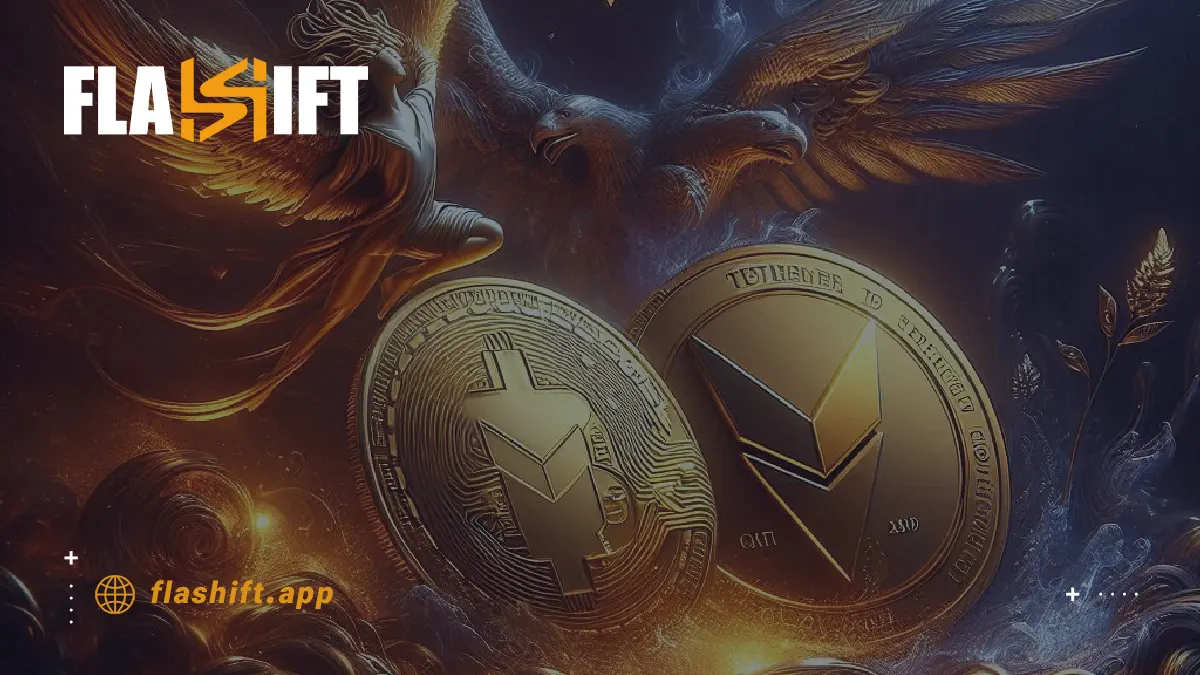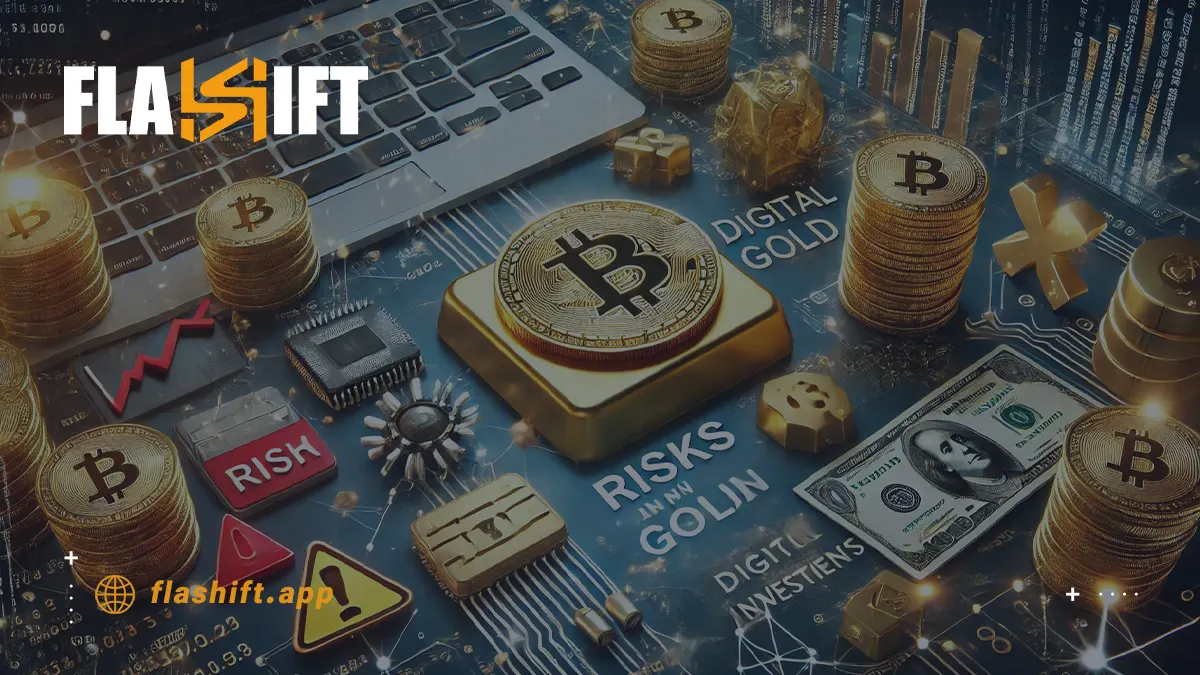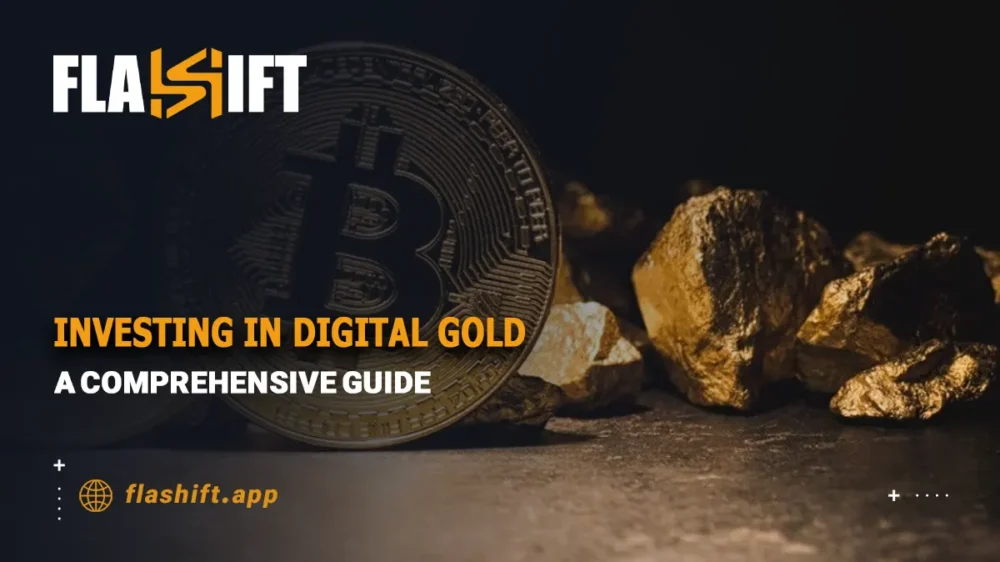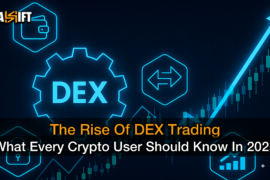Investing in Digital Gold | Over the years, ‘digital gold‘ has enchanted investors worldwide, changing the dimension of perception and interaction with money. Cryptocurrencies, being decentralized and having the potential for value storage, have been compared to digital gold and have become a cornerstone in modern investment strategies. From Bitcoin’s pioneering dominance to the innovative ecosystems of Ethereum and beyond, these digital assets offer opportunities and challenges for savvy investors.
From the most well-known digital assets and their unique features to strategies that will help you wade through this dynamic market, this comprehensive guide covers it all. Whether one is a seasoned investor or a new entrant, this article details the insights required to understand and capitalize on the potential of investing in digital gold.
Understanding Digital Gold in the Cryptocurrency Era
It has come to mean a synonym for cryptocurrencies, a modern store of value, and hedge against economic uncertainty. Among them is Bitcoin, a popular comparison to gold due to its scarcity, durability, and decentralized nature. However, the term “digital gold” does not apply to Bitcoin alone but generally to all other cryptocurrencies that usually would guarantee financial security and long-term value to anyone in a digitally operating economy.
Investment in digital gold has become a modern route for securing wealth in today’s world, burdened by problems like inflation and geopolitical instability affecting the traditional financial systems. It finds a place in modern finance, not only as an alternative to traditional assets but also due to the innovation it enables in blockchain technology. This whitepaper explains what digital gold is, its role in shaping the future of financial spaces, and how investors can use it as an opportunity to create robust portfolios in the cryptocurrency era.
Bitcoin: The Original Digital Gold
Bitcoin is the undisputed leading cryptocurrency pioneer, earning it the title of “digital gold.” From its creation in 2009 by the mysterious Satoshi Nakamoto, Bitcoin has redefined how money and value are perceived. While initially supposed to be a decentralized, peer-to-peer electronic cash system, the role of Bitcoin has evolved to that of primarily a store of value and has found its niche in the global financial ecosystem.

Bitcoin as a Store of Value
The characteristic that makes Bitcoin comparable to gold is its scarcity. With a capped supply of 21 million coins, Bitcoin is resistant to the inflationary pressures faced by traditional fiat currencies. This capped supply, along with the decentralized nature of the cryptocurrency, ensures that no central authority can manipulate its production value and thus is a hedge against economic uncertainty.
This cryptocurrency has recently been taken up by investors who have desired to protect their wealth amidst unpredictable world finances. Its decentralization and borderless characteristics guarantee the best security and ease of accessibility that individual and institutional investors look for. Bitcoin has come to mean investing in digital gold due to its position as the very first and most renowned cryptocurrency, therefore offering an unprecedented way of diversification, modern in nature, in front of the more traditional safe havens represented by gold and silver.
To exchange Tether (USDTERC20) to Bitcoin (BTC) in one second, Flashift is the easiest way.
Market Dominance and Leadership
Market dominance by Bitcoin is just the second witness of Bitcoin’s position as the first digital gold. Presently, Bitcoin holds the highest portion of the cryptocurrency market by capitalization, accounting for about 40-50% of the market. Its broadened adoption and very secure network with unparalleled liquidity are inarguably its reasons for this.
Furthermore, the influence of Bitcoin goes beyond its price movements, setting the tone for the wider cryptocurrency market; altcoins often follow the lead that Bitcoin shows. Large financial firms and publicly traded companies among institutional investors have increasingly allocated resources to Bitcoin, further solidifying its role as digital gold in modern finance.
Why Bitcoin is the Cornerstone of Investing in Digital Gold
For investors keen on investing in digital gold, Bitcoin is the most stable and established option. Its track record speaks volumes, its infrastructure is strong, and it becomes more acceptable day by day; thus, it must be an integral part of a cryptocurrency portfolio. Bitcoin’s less volatility in the market compared to other cryptocurrencies and its persistent long-term growth make it a safe and promising investment.
From concept to the manifestation of digital gold, Bitcoin’s journey epitomizes the radical changes that have been sweeping over world finance. In their offerings of a decentralized, capped, and secure store of value, Bitcoins continue to redefine how the concept of wealth preservation should be viewed in the light of the digital era.
Ethereum: Beyond Digital Gold
While Bitcoin dominates the narrative as the original digital gold, Ethereum has carved out a unique position in the cryptocurrency landscape, offering capabilities that extend far beyond being a store of value. Launched in 2015 by Vitalik Buterin and his team, Ethereum introduced the world to the concept of smart contracts—self-executing agreements coded directly onto the blockchain. This innovation has transformed Ethereum into a versatile platform for decentralized applications (dApps), setting it apart in the realm of cryptocurrency and digital finance.

Smart Contracts: The Core of Ethereum’s Value
The main feature of Ethereum is smart contract functionality, which enables developers to create programmable agreements that automatically execute when certain conditions are met. This functionality underpins everything from DeFi and tokenized assets to gaming and supply chain management. Unlike Bitcoin, which is often viewed as digital gold, Ethereum’s programmability as a blockchain makes it a foundational layer for the future of Web.
These smart contracts have driven the adoption of Ethereum by developers, businesses, and even governments, making it the most active blockchain ecosystem. To investors who would want to invest in digital gold, Ethereum represents an entry not only to a store of value but also to participation in the greater digital economy, including new growing sectors such as non-fungible tokens and decentralized autonomous organizations.
Ethereum’s Market Position and Growth
Ethereum continuously occupies the second position in the market capitalization ranking of cryptocurrencies, indicating its importance in the crypto world. Its position is further cemented in the transition to Ethereum 2.0, which is a major upgrade that is shifting the network to a proof-of-stake consensus mechanism. It has increased the scalability, energy efficiency, and security of Ethereum, hence attracting both developers and investors in great amounts.
To investors in digital gold, Ethereum is a complementary asset to Bitcoin, fusing the security of blockchain technology with innovative capabilities that will drive further adoption and utility. Its dynamic ecosystem and ongoing upgrades mean that Ethereum will continue to be on the leading edge of blockchain technology, further cementing its position as a market leader.
To exchange Tether (USDTERC20) to Ethereum (ETH) in one second, Flashift is the easiest way.
Ethereum’s Role in the Future of Investing in Digital Gold
What really makes Ethereum a necessity in a diversified cryptocurrency portfolio is the fact that Ethereum can go beyond being digital gold. Where Bitcoin excels at its store-of-value proposition, Ethereum’s programmability and adaptability expose investors to the transformational power of blockchain technology. In this dual role-as a valuable asset and as a functional platform-lies Ethereum’s continued attraction to investors desiring long-term growth in the digital asset space.
In the final analysis, Ethereum embodies a new dimension in investing in digital gold, offering much more than just wealth preservation. With its pioneering smart contract functionality and commanding market presence, Ethereum is both a cornerstone of the cryptocurrency ecosystem and a very attractive choice for investors seeking to capitalize on the full potential of blockchain innovation.
The Role of Decentralized Finance (DeFi) in Digital Gold Investment
Decentralized Finance (DeFi) has transformed the way investors interact with digital gold assets, offering unmatched accessibility and financial flexibility in the cryptocurrency ecosystem. Through DeFi platforms, investors can put their cryptocurrency holdings — including Bitcoin, Ethereum, and gold-backed tokens — to work by engaging in innovative tools like lending, staking, and yield farming. These opportunities not only generate passive income but also optimize the utility of digital gold investments by creating diversified income streams. For example, borrowing against these assets in a decentralized, trustless environment removes the barriers posed by traditional intermediaries, enabling seamless financial transactions.
In addition to earning yields, the DeFi landscape serves as the backbone of financial inclusion, democratizing access to investment opportunities that were once limited to institutional players. Its role in enhancing liquidity, reducing transaction costs, and providing access to global financial networks aligns closely with the broader appeal of digital gold investments. By integrating DeFi mechanisms into their strategies, investors can unlock new portfolio growth pathways, all while benefiting from the flexibility and security of blockchain technology. As DeFi continues to expand, it is an essential consideration for both seasoned and new entrants aiming to build robust digital asset portfolios.
Gold-Backed Cryptocurrencies: Bridging Traditional and Digital Assets
As the financial world increasingly embraces digital innovation, gold-backed cryptocurrencies have emerged as a bridge between the stability of traditional gold and the convenience of blockchain technology. These unique digital assets, such as Tether Gold (XAUt) and PAX Gold (PAXG), are designed to combine the timeless value of physical gold with the benefits of cryptocurrency, offering investors a new way to preserve and grow wealth.

What Are Gold-Backed Cryptocurrencies?
Gold-backed cryptocurrencies include digital tokens that are linked to physical gold reserves, usually with each token representative of a certain amount of gold, mostly one troy ounce, stored in vaults. The reserves are audited on a regular basis in order to ensure that tokens really have the promised gold in their backing.
This backing provides stability, with the intrinsic value of gold, while enabling the flexibility of cryptocurrency transactions. Unlike traditional investments in gold, gold-backed cryptocurrencies can be transferred instantly, traded on digital exchanges, and even used in decentralized finance platforms.
Tether Gold (XAUt) and PAX Gold (PAXG)
- Tether Gold (XAUt)
Tether Gold is issued by the creators of Tether (USDT), the most widely used stablecoin. Each XAUt token is backed by one troy ounce of gold stored in Swiss vaults. Tether Gold offers investors a cost-effective way to own gold, with low custody fees and the ability to redeem tokens for physical gold. - PAX Gold (PAXG)
PAX Gold, developed by Paxos, is another leading gold-backed cryptocurrency. Each PAXG token represents one fine troy ounce of gold held in London vaults. PAXG stands out for its compliance with strict regulatory standards, offering transparency and reliability. It is also highly liquid, allowing investors to trade and use PAXG tokens across a wide range of platforms.
Advantages of Gold-Backed Cryptocurrencies
Gold-backed cryptocurrencies offer several advantages over traditional gold investments:
- Liquidity: Tokens can be traded 24/7 on cryptocurrency exchanges, providing immediate access to funds.
- Fractional Ownership: Investors can purchase small fractions of gold, making it accessible to a broader audience.
- Portability: Digital gold can be transferred globally without the logistical challenges of moving physical gold.
- Transparency: Blockchain technology ensures secure transactions and traceability of ownership.
The Role of Gold-Backed Cryptocurrencies in Modern Portfolios
For investors seeking to diversify their holdings, gold-backed cryptocurrencies offer an innovative way to combine the stability of gold with the potential of blockchain technology. These assets are particularly appealing in times of economic uncertainty, serving as a hedge against inflation and currency devaluation.
In conclusion, gold-backed cryptocurrencies like Tether Gold and PAX Gold represent a unique convergence of tradition and innovation. By leveraging blockchain technology to enhance the accessibility and usability of gold, they provide investors with a modern, flexible approach to preserving wealth while maintaining the timeless allure of this precious metal.
Evaluating Prominent Cryptocurrencies for Investment
As the cryptocurrency market continues to evolve, identifying the best cryptocurrencies for investment in 2024 requires a thoughtful evaluation of key factors. With thousands of digital assets available, understanding the criteria that separate promising investments from speculative plays is essential. By focusing on aspects like market capitalization, technology, and use cases, investors can make informed decisions to maximize returns while managing risks.

Key Criteria for Assessing Cryptocurrencies
- Market Capitalization
It reflects the total value of a cryptocurrency and hence can be used as a determinant of its prominence and stability. Large-cap cryptocurrencies, such as Bitcoin and Ethereum, are usually less volatile and thus may fit for long-term investments. Middle-cap and small-cap coins provide greater growth, but with much higher associated risks. Comparing market capitalization enables investors to find assets that best suit their risk tolerance and financial goals. - Technology and Innovation
The underlying technology of a cryptocurrency is a very important long-term viability determinant. Projects with strong blockchain infrastructure, scalability, and security are better placed for success. For example, Ethereum’s smart contract capabilities, when combined with the emergence of layer-2 solutions like Polygon, make it one of the strongest contenders among the best cryptocurrencies to invest in 2024.
Moreover, the emergence of technologies such as proof-of-stake consensus mechanisms and cross-chain interoperability is pioneering the space of cryptocurrency. The cryptocurrencies that are well-utilized in these aspects really stand out, given their potential to solve real-world problems and enhance user experience.
- Use Cases and Adoption
The real-world utility of a cryptocurrency provides strong hints about its room for growth. Assets used to power decentralized finance (DeFi) protocols, non-fungible token (NFT) ecosystems, or supply chain management solutions have shown tangible value. On this count, Solana is at the top of many NFT marketplaces and gaming platforms due to its fast blockchain, while Chainlink’s oracle technology has become indispensable for DeFi applications. - Community and Ecosystem
A robust developer community and growing ecosystem are signs of a healthy cryptocurrency project. Active communities foster innovation, ensure regular updates, and drive adoption. Cryptocurrencies with well-established ecosystems, like Binance Coin (BNB) and Cardano (ADA), often feature diverse applications that reinforce their market position. - Regulatory Compliance and Transparency
Regulatory challenges continue to shape the cryptocurrency market. Projects that prioritize compliance, transparency, and security are better equipped to navigate legal hurdles and gain institutional trust. For instance, stablecoins like USD Coin (USDC) are often viewed as reliable investments due to their adherence to regulatory standards.
Choosing the Best Cryptocurrencies for Investment in 2024
Opportunities abound in the cryptocurrency market—investors willing to wade through the intricacies will find them. Investors can consider a host of factors that could possibly identify the best cryptocurrencies in which to invest in 2024, based on market capitalization, technology, use cases, and community support. Whether that be long-term investment in big players like Bitcoin and Ethereum or even high-potential altcoins, disciplined assessment usually leads to so much better decision-making in this rapidly moving market.
Risks and Considerations in Digital Gold Investments
As these cryptocurrencies continue to gain traction as a modern equivalent of gold, they present unique opportunities for wealth preservation and growth. However, just like any other financial asset, investment in digital gold comes with its own set of risks and challenges. It is very important for an investor to understand these factors while navigating the crypto market. This Digital Gold Investment Guide goes over key risks and considerations, thereby helping investors make informed decisions while safeguarding their assets.

-
Market Volatility
These cryptocurrencies, like digital gold assets including Bitcoin and Ethereum, are highly volatile. Prices can change highly within hours or even minutes, moved by market sentiments, economic events, and speculative trading activities. The same volatility that creates this potential for high returns also exposes investors to possibly large losses.
Mitigation Strategy:
- Diversify your portfolio to include both high-risk and stable assets.
- Use dollar-cost averaging (DCA) to reduce the impact of market fluctuations.
- Set realistic investment goals and avoid emotional decision-making during market turbulence.
-
Regulatory Concerns
The regulatory landscape for cryptocurrencies is still evolving, and changes in government policies can significantly impact digital gold investments. Restrictions, tax implications, or outright bans on crypto trading can lead to decreased market confidence and price drops.
Mitigation Strategy:
- Stay informed about the regulatory environment in your country and globally.
- Focus on cryptocurrencies that prioritize compliance, such as Ethereum or gold-backed tokens like PAX Gold (PAXG).
- Work with tax professionals familiar with cryptocurrency to ensure compliance with local laws.
-
Security Measures
The decentralized nature of cryptocurrencies makes them attractive but also exposes them to security risks. Cyberattacks, hacking of exchanges, and loss of private keys can lead to irretrievable losses. Unlike traditional financial systems, there is no centralized authority to recover lost funds.
Mitigation Strategy:
- Use reputable cryptocurrency wallets, such as hardware wallets, for secure storage.
- Enable multi-factor authentication (MFA) on exchanges and wallets.
- Avoid sharing private keys or recovery phrases and consider using cold storage for long-term holdings.
-
Liquidity Challenges
While major cryptocurrencies like Bitcoin and Ethereum boast high liquidity, smaller or niche digital gold assets might not. Limited trading volume can make it difficult to buy or sell assets at desired prices, especially during market downturns.
Mitigation Strategy:
- Stick to well-known cryptocurrencies with strong market capitalization and trading volume.
- Research the liquidity of less popular assets before investing.
-
Technological Risks
Blockchain technology is still maturing, and unexpected issues like network congestion, bugs, or vulnerabilities can impact the value of digital gold investments. Additionally, competition among blockchain projects could render some technologies obsolete.
Mitigation Strategy:
- Invest in cryptocurrencies with proven track records and active development teams.
- Stay updated on technological developments and consider diversifying into newer, more innovative projects cautiously.
A Balanced Approach to Digital Gold Investments
While digital gold investments present a tantalizing alternative to traditional assets, market volatility, regulatory uncertainties, security challenges, and liquidity risks all have to be weighed. This Digital Gold Investment Guide will help investors minimize risks and make confident decisions in this dynamic market. A balanced approach—one that combines due diligence with prudent risk management—ensures that digital gold can prove to be a valuable addition to any diversified investment portfolio.
Strategies for Investing in Digital Gold
The world of cryptocurrency offers exciting opportunities for wealth building, with investing in digital gold emerging as a popular strategy. Digital gold assets like Bitcoin and Ethereum serve as modern-day hedges against economic uncertainty, but investing in them requires thoughtful planning. Here are five key strategies to maximize your success while managing risks.

-
Diversify Your Portfolio
One of the fundamental principles of any investment strategy is diversification. While Bitcoin is often the cornerstone of digital gold investments, other assets like Ethereum, gold-backed cryptocurrencies (e.g., PAX Gold), or even promising altcoins can provide complementary benefits.
- Why Diversify?: Diversification reduces the impact of volatility from any single asset on your portfolio.
- How to Diversify?: Allocate investments across established cryptocurrencies for stability and smaller-cap coins for higher growth potential. Consider including gold-backed tokens for added security and tangible backing.
-
Adopt a Long-Term Holding Strategy (HODL)
Digital gold assets are often subject to extreme short-term price volatility, but their long-term trajectory has historically been upward. Adopting a “HODL” (Hold On for Dear Life) approach allows you to ride out market turbulence and capitalize on long-term gains.
- Why HODL?: Holding through market downturns helps avoid panic selling and missing out on subsequent recoveries.
- Tips for Long-Term Success: Focus on established cryptocurrencies like Bitcoin and Ethereum, which have proven resilience over time. Set clear financial goals and avoid frequent trading, which can erode profits due to fees.
-
Stay Informed About Market Trends
The cryptocurrency market is dynamic, with prices and sentiment influenced by technological advancements, regulations, and macroeconomic factors. Staying informed allows you to make timely decisions and adjust your strategy as needed.
- What to Monitor?:
- Technological updates, like Ethereum’s transition to proof-of-stake.
- Regulatory developments in major markets.
- Adoption trends by institutional investors and businesses.
- Tools to Use: Follow reputable crypto news platforms, subscribe to market analytics services, and engage with cryptocurrency communities for diverse insights.
-
Use Dollar-Cost Averaging (DCA)
Dollar-cost averaging is an investment strategy that involves purchasing fixed amounts of an asset at regular intervals, regardless of market conditions. This approach minimizes the impact of price volatility.
- Why DCA?: It reduces the emotional stress of timing the market and averages out the cost of your investments over time.
- How to Implement DCA: Set up automatic purchases of your chosen digital gold assets, such as Bitcoin or Ethereum, on a weekly or monthly basis.
-
Prioritize Security and Storage
Digital gold investments require robust security measures to protect against theft, hacking, and loss of private keys. Ensuring the safety of your assets is as important as choosing the right investments.
- Best Practices:
- Use hardware wallets for long-term storage.
- Enable multi-factor authentication (MFA) on exchanges.
- Regularly back up wallet recovery phrases and store them in secure locations.
- Avoid leaving significant amounts of cryptocurrency on exchanges, which are susceptible to hacking.
In Summary
Investing in digital gold is a great potential for long-term wealth creation, but it requires balance and an informed approach. A well-rounded investment strategy is built upon diversification of a portfolio, focusing on long-term growth, staying updated with market trends, using dollar-cost averaging, and most importantly, keeping the investments secure. With care and discipline, digital gold can be a cornerstone in your financial future.
Conclusion: Navigating the Future of Digital Gold Investments
Now, looking ahead, investing in digital gold represents a transformational opportunity amidst an ever-changing landscape of digital assets. Cryptocurrencies like Bitcoin, Ethereum, and gold-backed tokens are now offering new alternatives to traditional investment vehicles, with the potential for long-term wealth preservation and growth. As the market for cryptos matures, though, investors need to play it with a thoughtful and disciplined approach.
The volatility and regulatory uncertainties of digital assets call for an emphasis on prudent investment practices. Diversification, long-term holding strategies, and keeping informed about market trends will be a few of the keys in managing risks and seizing opportunities. Furthermore, it is very important to prioritize the security of your investments so that you can confidently participate in the digital gold revolution.
As the ecosystem of cryptocurrency matures, one has to be adaptable. The rise of new technologies, increasing institutional adoption, and changing regulatory frameworks will define the future of digital gold. Continue learning, diversify, and stick to sound principles so that you confidently sail in this dynamic space and set yourself up for success in the world of digital assets.
FAQ
- What is digital gold in cryptocurrency?
Digital gold refers to cryptocurrencies, like Bitcoin, that are seen as a store of value, similar to physical gold, offering a hedge against inflation and economic uncertainty.
- How is digital gold different from physical gold?
Digital gold is more liquid and accessible, allowing instant transactions and greater potential for growth, while physical gold is tangible but less flexible and harder to trade.
- Why is Bitcoin called digital gold?
Bitcoin is called digital gold due to its limited supply (21 million coins) and its role as a store of value, similar to gold in traditional finance.
- What makes Bitcoin dominant in the cryptocurrency market?
Bitcoin’s large market capitalization, widespread adoption, and network security make it the most recognized and established cryptocurrency, reinforcing its position as digital gold.
- Why is Ethereum important in the cryptocurrency ecosystem?
Ethereum enables innovations like decentralized finance (DeFi) and NFTs, positioning it as a foundational asset for blockchain technology beyond just digital gold.
- What are gold-backed cryptocurrencies?
Gold-backed cryptocurrencies are digital tokens pegged to physical gold, offering a blend of the stability of gold with the advantages of blockchain technology.
- Are gold-backed cryptocurrencies safe investments?
They offer stability due to gold backing, but they still carry risks like market fluctuations and regulatory concerns, so research is important before investing.
- What factors should I consider when investing in cryptocurrencies?
Key factors include market capitalization, technology, use cases, regulatory compliance, and community support.
- Why is use case important when evaluating cryptocurrencies?
Cryptocurrencies with real-world applications, like Ethereum’s smart contracts, are more likely to gain long-term value and adoption.
- What risks are associated with investing in digital gold?
Key risks include market volatility, regulatory uncertainty, cybersecurity threats, and technological vulnerabilities.
- How can I secure my digital gold investments?
Use secure wallets, enable multi-factor authentication, and store assets in cold wallets to protect against hacking and theft.
- How can I diversify my digital gold investments?
Diversify across different cryptocurrencies, such as Bitcoin, Ethereum, and gold-backed tokens, to balance risk and potential returns.







